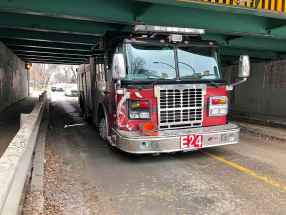Stories from the second storey The skywalk network is far from perfect, but it makes Winnipeg a better place for the people who live, work and play downtown
Read this article for free:
or
Already have an account? Log in here »
To continue reading, please subscribe:
Monthly Digital Subscription
$0 for the first 4 weeks*
- Enjoy unlimited reading on winnipegfreepress.com
- Read the E-Edition, our digital replica newspaper
- Access News Break, our award-winning app
- Play interactive puzzles
*No charge for 4 weeks then price increases to the regular rate of $19.00 plus GST every four weeks. Offer available to new and qualified returning subscribers only. Cancel any time.
Monthly Digital Subscription
$4.75/week*
- Enjoy unlimited reading on winnipegfreepress.com
- Read the E-Edition, our digital replica newspaper
- Access News Break, our award-winning app
- Play interactive puzzles
*Billed as $19 plus GST every four weeks. Cancel any time.
To continue reading, please subscribe:
Add Free Press access to your Brandon Sun subscription for only an additional
$1 for the first 4 weeks*
*Your next subscription payment will increase by $1.00 and you will be charged $16.99 plus GST for four weeks. After four weeks, your payment will increase to $23.99 plus GST every four weeks.
Read unlimited articles for free today:
or
Already have an account? Log in here »
Hey there, time traveller!
This article was published 29/11/2019 (2209 days ago), so information in it may no longer be current.
We see them as we pass by on our way to grab coffee, lunch or a library book.
In the climate-controlled skywalk above downtown streets, they play guitars, keyboards — even the Chinese stringed instrument called an erhu — while others offer a hand up from a religious point of view.
Some people toss spare change into a box, a guitar case or a can. A few stop for a moment to listen. And the odd one might get the life advice they need to help them through the day.
Many of the thousands who rush past avert their eyes or quietly move to the other side of the skywalk.
These are not street people. Some may need the money for a special purchase, others to get by that month. Others do it just to bring joy to strangers.
Those people who use the skywalk — officially called the Winnipeg Walkway System — are not hamsters in a Habitrail tunnel system. They can be children heading to and from a nearby daycare. They could be people living with special needs who need to get away from the ice and snow for mobility. And they could just be people scurrying to a business meeting.

There is a whole world up here, just one flight up from the street. There’s access to a library. An NHL hockey and concert facility. Restaurants, hotels and services. A major department store. Government offices. Banks and credit unions. Pharmacies. Live theatre.
It’s a seasonal community, for the most part. Activity peaks from when the mercury and leaves drop to when the snow melts and spring’s first flowers emerge. During the summer months that activity dies down and people spill onto the streets until the season changes again.
Here are a few of the stories of the people you meet in the skywalk.
● ● ●
A few times a month, usually a weekday mid-morning, a woman rolls her motorized wheelchair through the skywalk looking for a spot to set up to play her music.
Olive Yaremko has an oxygen tank strapped on the back of her chair from which a long, thin clear tube snakes around her body, ending with prongs resting in her nose. On her lap, and over the armrests of her chair, is a large flat case, while rolling along beside her is a suitcase on wheels.
A touch of whimsy: a spray of vibrant plastic flowers is attached to the wheelchair beside her head.
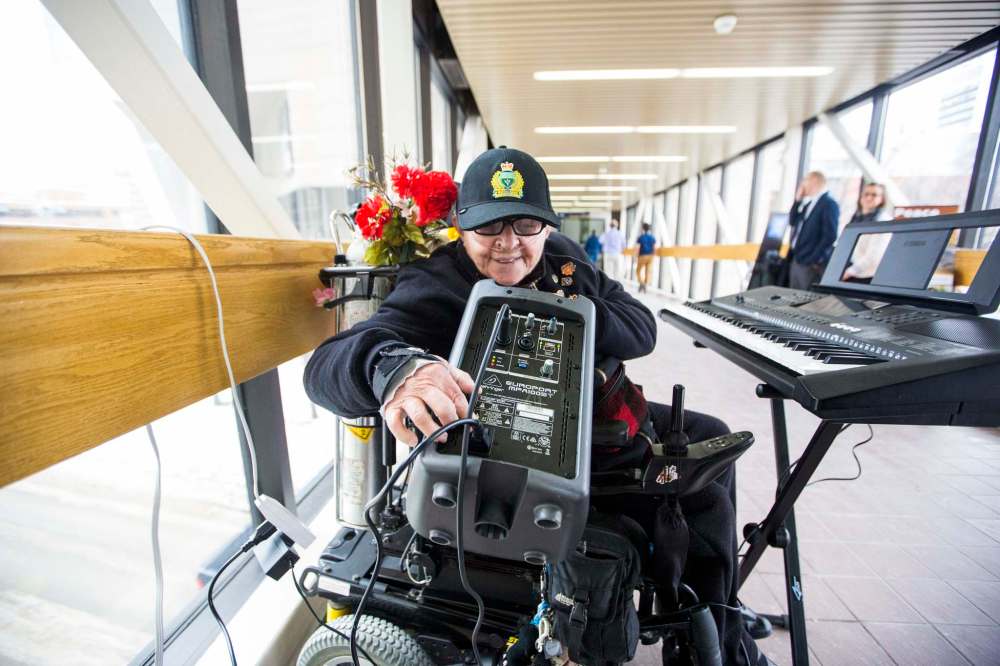
Yaremko is looking for a spot that has an electrical outlet. She finds one between the Millennium Library and the Winnipeg Police Service headquarters.
Yaremko pulls several items out of her bag, starting with an extension cord. Her dexterity while sitting in the chair is impressive. She snaps open the flat case and out comes a keyboard, which she places on the stand she sets up. She pulls out and plugs in a small speaker before setting it on the floor.
Once everything is assembled, she powers up her setup. Then Yaremko’s fingers begin running over the keyboard. She’ll be here for the next few hours — longer and into the evening if there’s a Winnipeg Jets game.
“I’m 73 and I’m still alive to play,” she says with a laugh while taking a break. “I’ve been playing since I was five years old…
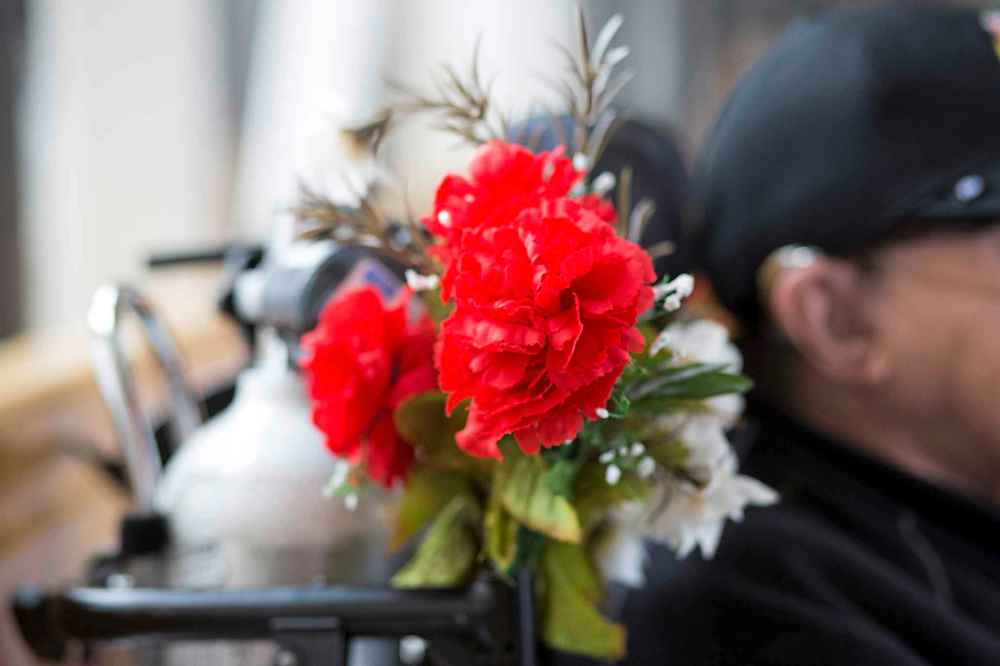
“I even have microphones. I give announcements, not only about songs, but when the Jets play.
“Maybe I’ll be a music star!”
Yaremko grew up on a farm near Dauphin, where the first instrument she learned to play was the mouth organ.
“My mom would hum a tune and I would play it on the harmonica,” she says.
Yaremko then learned to play the accordion, even playing in a local band where she grew up. While her sister took lessons, she didn’t need to, she says.
“I’ve always had an ear for music… when I was in the band there were four of us playing and we would do wedding socials,” she says, smiling at the memory. It quickly disappears.
“One of my partners died of cancer at 25 — he was my rhythm player.”
Yaremko has used a wheelchair since she was assaulted in 1995. She’s hesitant to talk about it, fearing it could happen again.
“The assault damaged my spine,” she says. “For 23 years now I’ve had to use a wheelchair. I have no feeling in my leg.”
“Some people, they’ll go by and they’ll hear a song and they’ll say, ‘I love that song.’ It makes them happy and I like to make them happy.” – Olive Yaremko
She’s been playing music in the skywalk for about six years.
“I tried it to see how it would work for me and it works great,” she says.
Yaremko’s repertoire is heavy on country music, but she also plays classical, Ukrainian and polka tunes. “Lots of people like polkas and waltzes,” she says, adding she doesn’t care for rock.
Yaremko starts playing the first notes of I Can’t Stop Loving You, made popular by Ray Charles a half-century ago.
“Some people, they’ll go by and they’ll hear a song and they’ll say, ‘I love that song.’ It makes them happy and I like to make them happy.”
Yaremko plays a veritable songbook of tunes.

“I play to six o’clock, and I’ll play until seven if there’s a hockey game,” she says. “I come early in the morning so it’s a long day, but I love to play.”
The loose change people toss her way does help. She says she pumped a lot of it into the Yamaha keyboard she plays, which also has percussion sounds.
“I love this keyboard so much — it makes me a one-lady band,” she says.
The donations also help her buy the little things she is not able to afford with her pension.
“You pay rent and utilities and there’s not much left,” she says. “It’s $50 per month for my oxygen tank rental. I pay for the tank and the government pays for my oxygen.
“I can’t breathe without it. Some people turn it off as joke — when that happens I pass out. But I expect to be around for a while. I want to live to over 100 years old. My dad’s sister was 105. I know by staying active you will live longer.
“And music is good for your soul. And it makes people happy.”
● ● ●
There’s more than two kilometres of skywalk to travel from the southeast corner of the second floor of The Bay at Portage Avenue and Memorial Boulevard to a parkade on Albert Street in the Exchange District. Most of it is a storey above ground, but there are sections at street level and underground, as well.
Kate Fenske, CEO of the Downtown Winnipeg Biz, is a frequent traveller in the skywalks.

“While we love to see hustle and bustle on our streets downtown, we know when the weather gets cold, people flood the skywalk system,” she says.
“It’s a great way to move through downtown, visit the connected businesses and stay warm. The more positive and vibrant activity we have (at) street level or in the skywalks downtown, the better.”
The future ownership of Portage Place and the land it sits on is currently in play with Starlight Investments, a Toronto developer, offering $22.9 million for the mall to Vancouver-based Peterson Group, and $47.9 million to the North Portage Development Corp., for the land and underground parking lot.
The controversial three-storey Portage Place mall and high-rise housing project, which required the expropriation of properties on several blocks north of Portage Avenue, was originally funded by all three levels of government through the Core Area Initiative and opened in fall 1987.
Fenske doesn’t know if new ownership will revitalize the skywalk system. Many of the retail businesses that were located inside have long since vanished, replaced with small offices and community organizations.
“The hope is there will be more activity and that would help all businesses,” she says.
“The skywalk is a benefit to so many people. You can go to lunch and back to work without putting on a coat in February. I go to so many places and use many different ways to get there, but if I’m looking to stop for a specific place, I’ll take the skywalk.”
● ● ●
Towards the east end of the skywalk system, just where it suddenly cuts north towards Winnipeg Square, Lucien Spence pulls a guitar out of its well-worn case and begins strumming.
You could say Spence is Nashville-ready as people walk past and buses crawl by underneath.
Nashville Ready is the name of a song Spence — wearing sunglasses, his hair tied back in a ponytail, and dressed all in black — wrote last year with his songwriting and business partner, Portage la Prairie businessman Dave Rodgers.
“Check it out — it’s a really good song,” he says.
Spence’s music can be heard on Indigenous radio stations across North America, including NCI, QX 104 and CFRY in southern Manitoba, but today he’s playing for donations. His booming, gravelly, bluesy voice bounces off the walls and reverberates further down the skywalk.
“I just found out about this place from a friend of mine,” he says. “I’m a local musician, but I’ve played all over. I do this for practice. I just practise my songs and my vision.
“I’ve been playing for 20 years, but only in the last year-and-a-half have I been recognized for my music. A lot of my music was about Indigenous issues, but now I’m putting it out to everyone.”

Spence is from Crane River, a Métis community next to the Crane River First Nation, located on the northwest side of Lake Manitoba. He says his parents were both musical.
“My dad was amazing,” he says. “Music is always in me.”
The strings at the end of his Simon and Patrick guitar, manufactured a few hours from Montreal in the small Quebec village of LaPatrie, stick out like a cat’s whiskers. Spence likes it that way.
“I’m not fussing with my guitars,” he says. “As long as it sounds good.”
Spence says he learned to play when he was 12, but didn’t start singing until he turned 18.
He’s now 43 and old enough to know what he really wants. Last year, he went to Nashville with Rodgers to see if he could play there.
“I ended up doing seven shows,” he says.
“I went to one place with guitars on the wall and they let me try a guitar. A manager comes out and says he really liked it — ‘Would you like to play in our lounge tonight?’ I did three sets. Then we called Tootsies (Orchid Lounge), a very famous spot in Nashville (located across the alley from the renowned Ryman Auditorium, the original Grand Ole Opry House) — Blake Shelton has played there. I played there and it was fun. I had a great reaction. It was one big party there.
“We went to Nashville just to get a feel. I didn’t get taken off the street to record, but it was fun.”
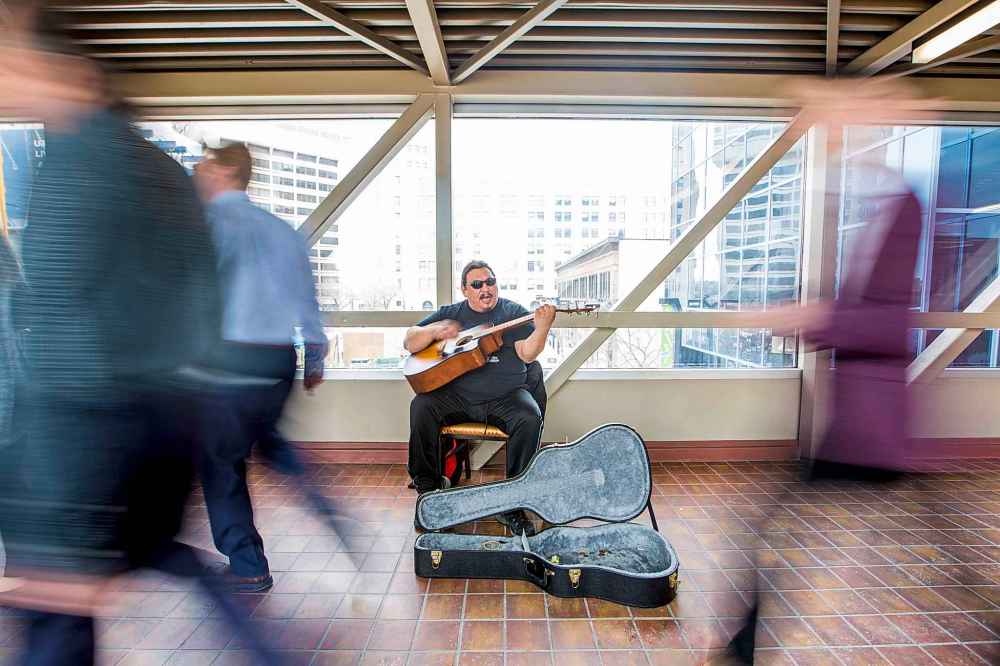
Before Spence belts out a muscular version of Johnny Cash’s Folsom Prison Blues, he says singing in the skywalk is, in no way, a step down after basking in the bright lights of Music City, U.S.A.
“I know a lot of people have a bit of a misunderstanding about busking,” he says.
“They think it’s begging, but it isn’t. I sit here and I sing my songs. Friends say, ‘What are you doing here?’ and I say, ‘What do you mean? Anywhere you can play and get heard is the best.
“It is an appreciation of music. I’m not here to get money. Here you get a little bit of exposure. It gets my music out more.”
● ● ●

In a winter city where sidewalks aren’t always cleared of snow and ice, the system is a vital network for many.
“It allows people to move around the whole downtown and makes our city more livable,” says David Kron, executive director of the Cerebral Palsy Association of Manitoba. “My thought is it should be expanded further.”
But Kron admits the skywalk isn’t perfect. The slope inside the section that crosses Fort Street is greater than what is allowed for ramps into buildings. A lift being broken inside the Portage and Main concourse can prevent access in or out of the system. Construction at Bell MTS Place severed the skywalk for most of the summer.
“A person in a wheelchair wanted to come to see me (this summer), but the door was closed at (the arena). He was two-thirds of the way here and he couldn’t make it.”
And that’s a problem, he says, because the skywalk system makes it so easy to access many areas downtown; it’s a major reason that many people living with special needs or mobility issues have decided to live in the housing complex that was built behind the mall, including Fred Douglas Place.
“I know there’s a higher percentage of members in that building who use wheelchairs and that’s why they picked that place to live,” he says. “There are Manitoba Housing units there which are subsidized.”
● ● ●
There are no guitars or keyboards, but Darren Rapp and several others are singing a different tune from another songbook anyway.
Darren Rapp is a Jehovah’s Witness. Several times a week he and other volunteer members of the church stand in pairs at several points along the skywalk, from the concourse under Portage and Main to the library.
“We do a public ministry. We are motivated by love of God and love of our neighbour. We want to share the Bible’s message with people.”

Rapp, who has lived in Winnipeg with his wife for more than a year, says when they’re in the skywalk they don’t approach people or speak to them.
“We wait for people to approach us,” he says. “When people want to talk we give an answer to a question from the Bible.”
The two most common questions they get are, ‘Does God care about me?’ and ‘How can I improve my marriage?’
“We also direct people to go to our website (jw.org),” he says. “Everything we have on our literature is on our website in all kinds of languages.”
“Our message is not out to get new members. We want to share thoughts from the Bible. It is a community service. People can get practical help from the Bible.” – Jehovah’s Witness Darren Rapp
Rapp says they also let people know about their places of worship, which are called Kingdom Halls, and their Bible meetings. Everyone is welcome, even non-Jehovah’s Witnesses, he says. And it’s free; there is no collection.
“Our message is not out to get new members,” he says. “We want to share thoughts from the Bible. It is a community service. People can get practical help from the Bible.
“But some (people going by) just wonder why we’re there. People ask what we are about, to just stand there.”
Volunteers are in place Monday to Friday from the morning to 6 p.m., with about two dozen people per day needed to fill the schedule.
“We enjoy doing it,” Rapp says. “We meet all sorts of people. We can help a few people through life’s challenges and give them hope for the future.
“We love to share the good news.”
● ● ●
Irene Semaniuk is the executive director of a unique daycare in the city. Not only is it downtown, with access to a modern play area on the top storey of a building, it’s also likely the only daycare in the city where, when its young charges go on an outing, even if it is snowing or raining, they stay warm and dry.
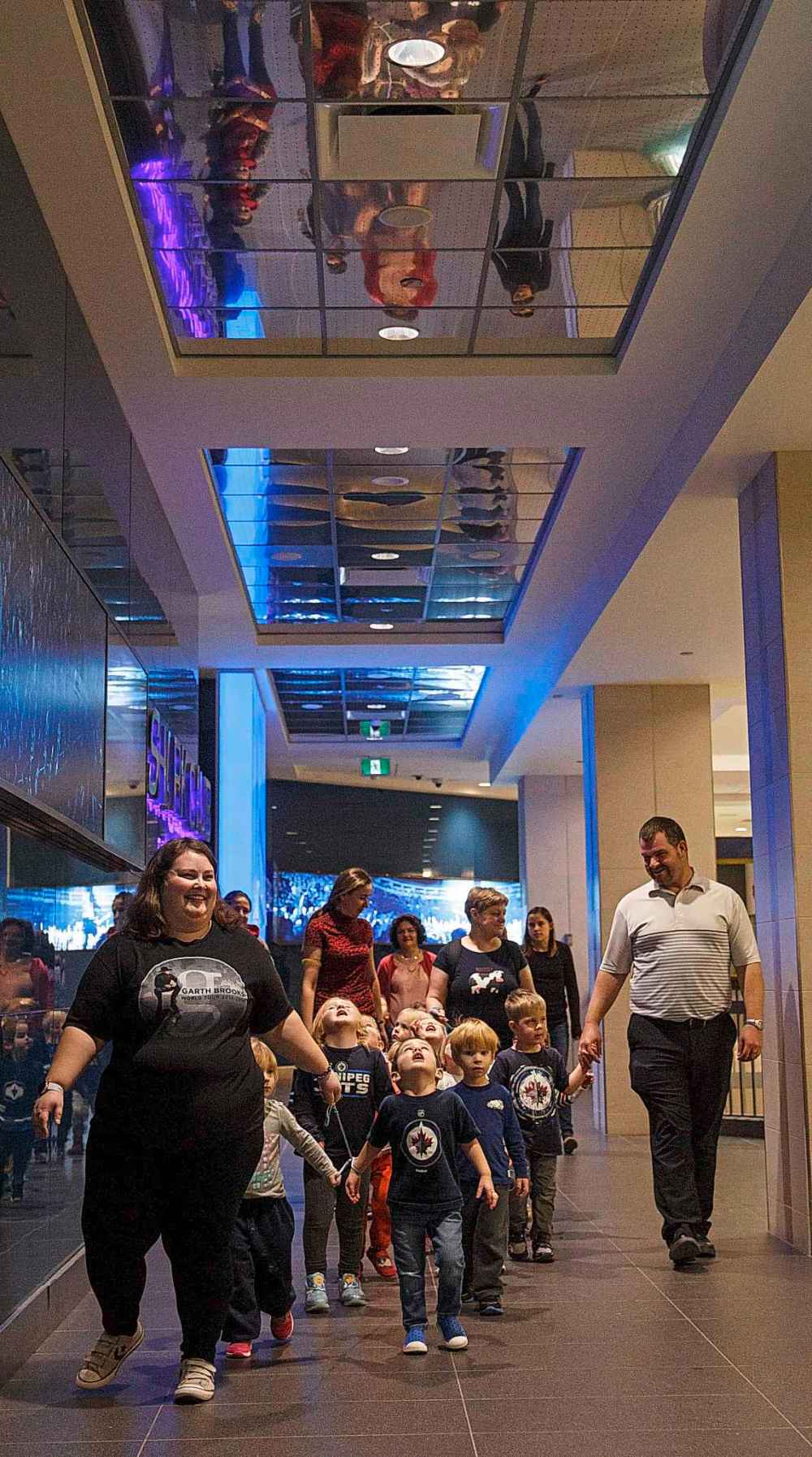
That’s because the facility is connected to the skywalk.
“We have a rooftop playground — because we are downtown, we do not venture on to downtown streets,” Semaniuk says.
“The skywalk is perfect for our needs. We take them to the library for story time. They can get physical exercise. We take them to watch the fountain in Portage Place. They look at going to the skywalk as, ‘We’re going into the tunnel.’
“They’re having fun.”
And, when the Winnipeg Jets are in town or Halloween, the kids take in the excitement.
“We get them really hyped-up for events like that. And for Halloween we’ll do a bit of a parade with their costumes on.”
● ● ●
It can be as cold as the Arctic outside, but Anita Issaluk — who is used to frigid weather because she was born and raised in Chesterfield Inlet in Nunavut — plays her guitar, perched in the warm confines of the skywalk section between the Millennium Library and Cityplace.

Issaluk’s guitar is festooned with so many stickers you would swear the guitar is half made from them. Mostly they’re from radio stations — NCI 105.5, CJOB, POWER — but there are also ones linked to Nunavut and the Firefighters Burn Fund. At times she accompanies her playing with a harmonica, other times she sings.
“I’ve been coming here for a couple of years,” she says.
“I come when I just feel like playing, when I have the energy. I just need to come here to promote my music. I don’t come here just to make money. I come here for my music.
“I would rather be here than just playing at home — people probably just think I’m a bum. But there’s more to me than just being out here.”
Besides a box on the floor for donations, Issaluk has copies of a compact disc, titled Arctic Wind, she recorded in 2010 priced at $20. She wrote all 17 tracks. It’s the only one she has for sale, but it’s not her first: she released Songs from the Northern Heart in 1999, and, before that, she had a self-titled CD produced by the CBC.
“The hour never fails to come for everyone’s dream to come true, whether it’s big or small,” the mother of three adult children wrote in the liner notes for Arctic Wind.
“To friends from school, we have survived the unsurvivable, some of us still suffer today, but we will not be for long. Through spiritual guidance and help from elders, we made it this far, and lets continue to follow our dreams.”
Issaluk said she wasn’t able to properly promote the CD at the time it was released because she suffered an injury. Now she is making up for lost time.
“I had a severe accident; I slipped,” she says. “If it wasn’t for the police I wouldn’t be alive today. They told me I looked just like a big plastic bag… it affected my behaviour for a long time.”
When Issaluk isn’t creating and playing music, she carves soapstone. She learned to carve by watching her father when she was young. In the last 20 years, her artwork it has been in exhibitions across North America and overseas, as well as being written up in Inuit Art Quarterly.
“But music, I find, is more my love,” she says. Mind you, I make way more (money) carving, but I love music.”
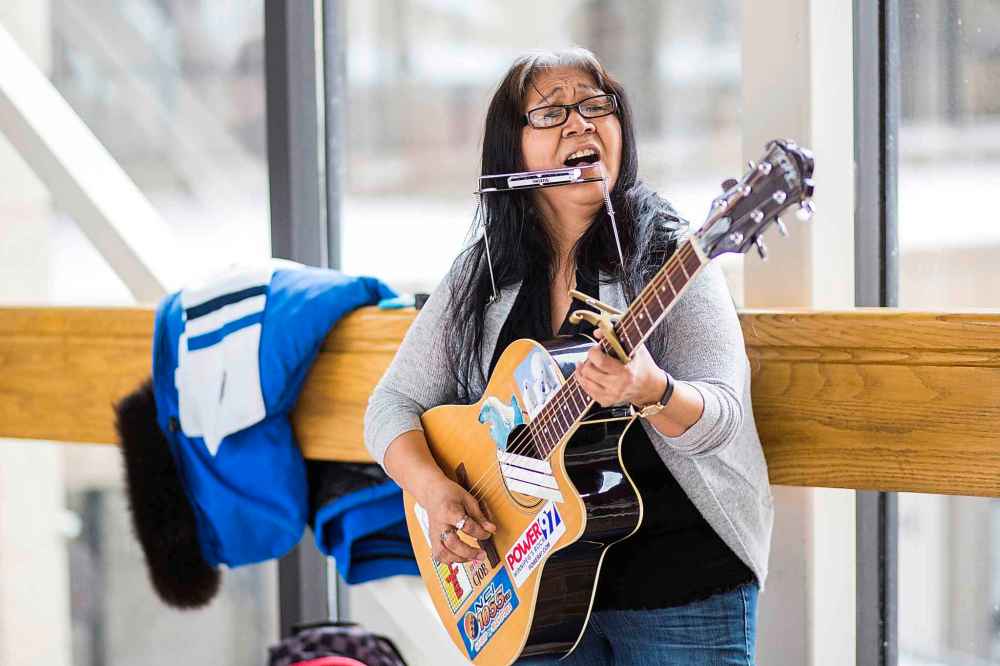
Issaluk has two dream gigs — the Winnipeg Folk Festival and at National Aboriginal Day celebrations.
She says people who walk past her in the skywalk, even if they don’t stop, appreciate the music.
“The people just love my music as they go by. And when they come back they buy my CD. Then they come back and say how well it is made.
“I really want to thank people in Winnipeg for so much support.”
● ● ●

Disability-rights activist Allen Mankewich lives with special needs and uses a wheelchair to get around. He lives and works downtown, so it is not surprising the skywalk is his usual route.
“I use it pretty extensively several times a week,” Mankewich says. “My building is not connected to it, but it is close enough. I just go across the street and I’m into it.
“But if a lift or an elevator is out you can’t use it.”
Mankewich has been vocal in the past when lifts in the concourse under Portage and Main have been out of service for long periods of time. When that happens, not only can’t Mankewich easily cross the intersection there, but it also impedes his most direct access to the skywalk system.
It has been a similar story in recent weeks because Artis REIT, which is building a 40-storey tower above Winnipeg Square near Portage and Main, put up signs announcing the elevator at the south end of the mall, which provides access from the concourse level to the skywalk system, would be closed as of Sept. 25. A nearby tenant learned it will be closed for months. People are being told they have to go to the Portage Avenue end of the mall to take an elevator to access the street.
“I use it pretty extensively several times a week.” – Disability-rights activist Allen Mankewich
“That’s not acceptable,” he says.
Mankewich uses the skywalk more during the winter months than summer.
“Depending where I’m going, I’ll definitely use it,” he says. “And, after a big snowfall, when it is more difficult to get around. It is definitely advantageous to use it during winter.
“But it can be a bit of a circuitous route, depending on where you are going.”
● ● ●
While traffic hums below on Portage Avenue, music is humming above.
For two decades, the Graffiti Gallery has helped emerging young artists on Higgins Avenue. But about five years ago, it opened Studio 393 in Portage Place to help other youths.
Now Studio 393 — the name is a nod to its original address on Portage Avenue — has moved to the skywalk. It takes up a section between Portage Place and The Bay, where a few merchants used to be located in individual stores.
“We are a youth arts drop-in,” says Elliott Walsh. “We do visual art here, but we also have a recording area, where youth can do beats. They can record here, write songs, learn how to write songs and performances. It’s a multi-purpose centre that caters to youth.
“It is also a safe place for a lot of youth. Even if they don’t want to do anything here they’ll stay here with their friends.”
Studio 393 is open five days a week, Monday to Friday, from 4 p.m. to 8 p.m. Facilitators help the youths with digital media, rap lyrics and arrangements, piano and music theory, breakdance, Afrobeat and radio and podcast mentorship.
And it is all free for people between the ages of 14 and 28.
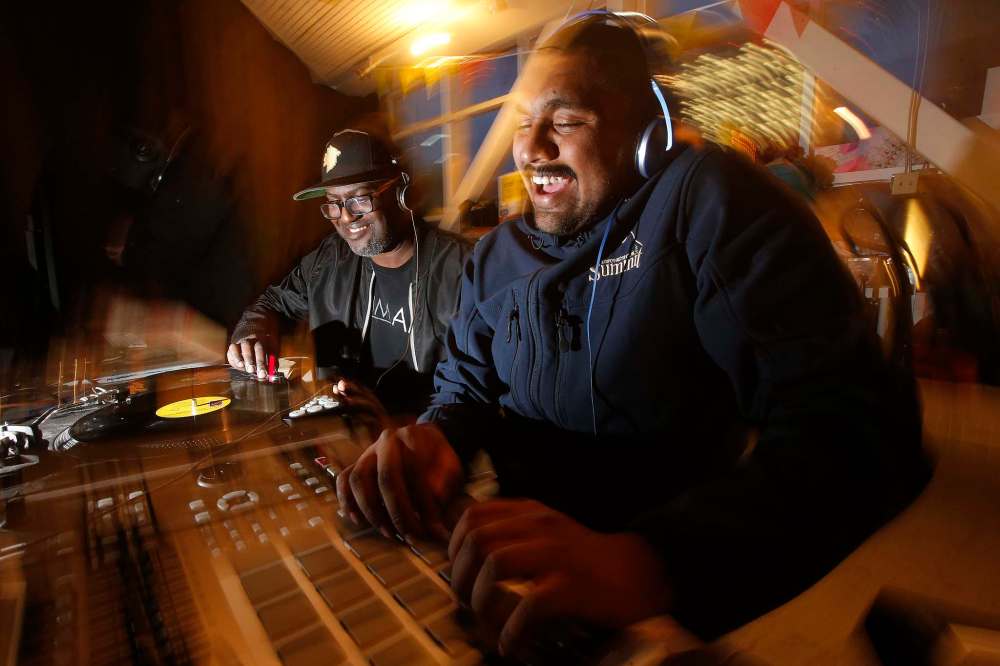
Osani Balkaran, 20, is one of the “graduates.” He started coming when he was 12 and is now a program instructor.
“I really liked visual art — painting and drawing — and I had heard you could do that here,” Balkaran says.
But it wasn’t long after Balkaran first came in that both he and his art changed direction.
“I got into rap, writing music, making music,” he says. “I really like synthesizers and electronics. I like to instruct on what people want to learn. If they want to learn to record, I’ll have them record. If they want to learn beats, I’ll show them.”
The site itself is conducive to creating his music, he says.
“The sound of traffic on the street. Everything is moving here and your brain is running. It is pretty inspirational for making music.”
kevin.rollason@freepress.mb.ca

Kevin Rollason is one of the more versatile reporters at the Winnipeg Free Press. Whether it is covering city hall, the law courts, or general reporting, Rollason can be counted on to not only answer the 5 Ws — Who, What, When, Where and Why — but to do it in an interesting and accessible way for readers.
Our newsroom depends on a growing audience of readers to power our journalism. If you are not a paid reader, please consider becoming a subscriber.
Our newsroom depends on its audience of readers to power our journalism. Thank you for your support.


